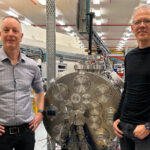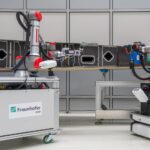Self-healing thermoplastic resin carbon-fiber-reinforced composites patented by NASA
The invention relates to the field of damage and impact tolerant carbon-fiber-reinforced composites (CFRC) and more particularly for structural aerospace applications.
The initiation and propagation of damage ultimately results in failure of aerospace structural components. Typical structural repairs often result in damaging practices, where material is ground away and holes are drilled to secure patches, which can act as new sites for damage. By healing known damage or by providing healing material to areas that are suspected to incur damage, improved safety can be realized.
Damage-tolerant, self-healing structural systems provide a route towards this objective. Effective self-repair, however, requires that these materials heal quickly following low-and mid-velocity impacts, while retaining structural integrity. Structures that make use of self-healing engineering materials produce a response from a change in the material’s chain mobility as a function of the damage.
In recent years, researchers have studied different “self-healing mechanisms” in materials as:
-
a collection of irreversible thermodynamic paths where the path sequences ultimately lead to crack closure or resealing.
-
an approach which involves the autonomic healing concept, where healing is accomplished by dispersing a microencapsulated healing agent and a catalytic chemical trigger within an epoxy resin to repair or bond crack faces and mitigate further crack propagation.
-
an approach which utilizes a polymer that can reversibly re-establish its broken bonds at the molecular level by either thermal activation, or ultraviolet light.
-
an approach with structurally dynamic polymers that produce macroscopic responses from a change in the materials’ molecular architecture without heat or pressure.
-
an approach which involves integrating self-healing resins into fiber reinforced composites.
The aforementioned self-healing approaches that address the repair or mitigation of crack growth and various damage conditions in materials, have the following disadvantages:
-
Slow rates of healing
-
Use of foreign inserts in the polymer matrix that may have detrimental effects on composite performance
-
Samples have to be held in intimate contact or under load and/or fused together under high temperature for long periods of time
-
The material may not be considered a structural load-bearing material
A self-healing composite laminate system that possesses aerospace quality consolidation with fiber volume fraction (FVF) of up to 57 percent and void volume fraction of less than two percent does not currently exist. Most self-healing composite laminates that have been reported possess 20-30 percent fiber volume, which is well below aerospace industrial standards for fiber-reinforced composites (FRC).
A need exists for an inherently self-healing composite laminate matrix that does not rely on foreign inclusions for self-repair and which has mechanical properties with potential for aerospace applications.
Summary of the invention proposed by NASA (patent WO/2013/172904):
A composite comprising a combination of a polybutadiene graft copolymer matrix, and a carbon-fiber reinforcement is provided. Additionally, a method of fabricating a composite comprising the steps of manufacturing a pre-impregnated unidirectional carbon fiber preform by wetting a plurality of carbon fibers with a solution, the solution comprising a self-healing polymer and solvent, and curing the preform, is provided. Moreover, a method of repairing a damage composite of the invention is provided.
In one embodiment, a polybutadiene graft copolymer (PBg) was selected as a matrix in carbon-fiber-reinforced composites due to its higher mechanical and thermal properties as compared to the other self-healing thermoplastics which have been studied. According to material suppliers, PBg has a glass transition temperature Tg=80 degrees Celsius (°C), room temperature (RT) tensile strength of 37 MPa, RT tensile modulus of 2.47 GPa, and a 7,5 percent elongation at break. The tensile modulus of the neat polymer is about 10 percent lower than the 2.76 GPa required of matrix polymers typically used in aerospace primary structural applications. In one embodiment, the matrix is a polybutadiene graft copolymer matrix, such as a polybutadiene graft copolymer comprising poly(butadiene)-graft- poly(methyl acrylate-co-acrylonitrile). In some embodiments, the matrix is a soluble matrix that allows for processing of the self-healing thermoplastic composite. In further embodiments, the solvent used to process the matrix is N-metbylpyrrolidone..
A composite fabrication process cycle was developed from composite precursor materials to fabricate composite laminates for aerospace structures. The precursor material is a pre-impregnated unidirectional carbon-fiber preform, also known as a prepreg. In the prepregging process, the high-strength, structural reinforcing carbon fiber is wetted by a solution containing the self-healing PBg polymer dissolved in N-Methylpyrrolidone (NP). Precursor materials in the form of unidirectional prepreg are widely used in the aerospace industry to fabricate and manufacture aerospace composite structures for both commercial and military aviation and space launch vehicle systems. The experimental prepreg containing the puncture-self-healing polymer PBg was characterized and a cure cycle developed to be used in fabrication of composite laminate test coupons from this novel prepreg material..
The composite of the present invention can be useful for structures in applications such as, but not limited to, structural components that can be incorporated into vehicles such as aircraft, rotorcraft, and spacecraft. Particular applications that can include these structural components are by way of example and not limitation, combat aircraft, large military transport and bomber aircraft, commercial transport, small transport, general aviation, military rotorcraft, commercial and general aviation rotorcraft, spacecraft, and missiles.
Fonte: JEC Composites












